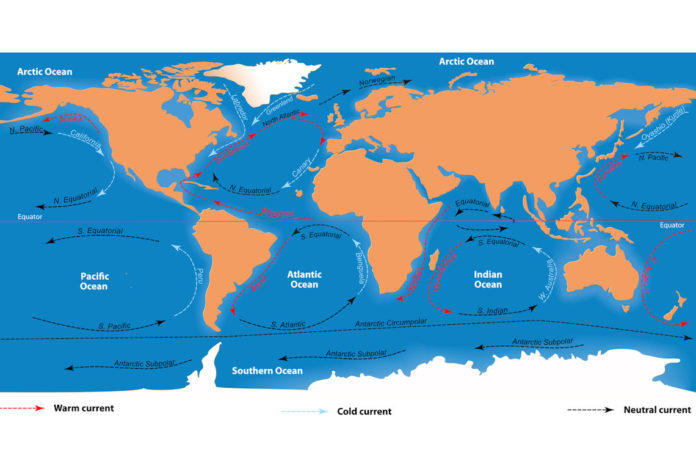Ocean currents are large scale movements of surface sea water. A surface ocean current follows a circular pattern. These movements of water play an important role in shaping the earth’s climate. The movement of the water is driven mostly by the winds.
The Ocean Current
The ocean currents get their energy from the trade winds. In the Northern Hemisphere, the winds blow from the northeast to the southwest. This results in the clockwise movement of the surface water in a gyre. A gyre is a circular movement of water. Most of this movement occurs in the top 100 meters of the ocean.
In the Southern Hemisphere, the winds blow from the southeast to the northwest. This results in the counter-clockwise movement of the ocean currents.
Ocean Currents and Climate
When warm water from the equator move to the polar regions affects the Earth’s climate. The ocean warms coastal area with the energy that it is carrying. For example, western Europe has a milder climate than countries deeper in the continent.
Other Types of Currents in the Ocean
In addition to surface ocean currents, there are two other types of currents.
Tidal Currents
Smaller scale and more local currents may be caused by the tides. During the high tide, the water moves inland and floods the shore. During the low tides, the water recedes from the shore. This is a tidal current.
Thermohaline Currents
In addition to wind driven currents, there are deep sea currents. These deep water currents may flow thousands of meters below the ocean’s surface. In the earth’s polar regions, sea water is frozen. As the water turns into ice, the seawater becomes more salty and more dense.
The cold and salty water is very dense and begins to sink. This begins the movement of water from the surface at the polar regions in the North Atlantic to the ocean depths. The deep ocean current then begin a journey to the South polar regions. Cold and salty water then recharges the ocean currents in the Antarctic.
The currents then travel into the Indian and Pacific Oceans. There, the waters begin to warm and rise up and become part of the ocean currents at the sea’s surface. The warmed waters eventually move back to the North Atlantic and start the cycle again.
Reflections
Vocabulary
- ocean current
- thermohaline current
- tidal current
Notes
- Surface ocean currents are primarily driven by the earth’s wind systems.
- Tidal currents are driven by the daily rise and fall of the tides.
- Deep-water thermohaline currents are driven by the cooling and higher density of salt water.
Bibliography
- A Hydrosphere Study Guide
- About the Hydrosphere
- Surface Ocean Currents, NOAA.

